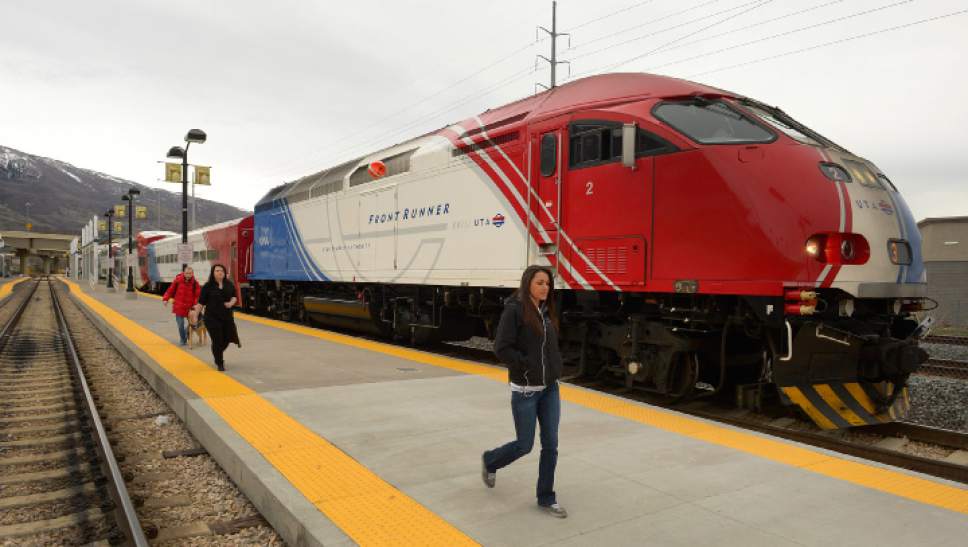This is an archived article that was published on sltrib.com in 2016, and information in the article may be outdated. It is provided only for personal research purposes and may not be reprinted.
After past criticism over its sweetheart deals for developers, the Utah Transit Authority Board unveiled a proposal to improve its oversight and design of transit-oriented developments.
The plan, released Wednesday, includes better screening its partners, taking back and reworking projects that have been slow to advance, creating concepts for sites before choosing developers, better ensuring that projects meet community goals, and improving follow-up to ensure developers deliver on promises.
These transit-oriented developments, often called TODs, are housing, retail and office projects near rail stations designed to help increase ridership. UTA has struck agreements in recent years to offer some of its land in exchange for a partnership in projects, and a share of future profits. That has led to controversy and critical audits.
For example, a legislative audit in 2014 said UTA "prepaid" developer Jeffrey Vitek $10 million to build a parking garage at the Draper FrontRunner station — which he never actually built. UTA had not managed at the time of the audit to retrieve all of its money.
The audit said UTA essentially acted as Vitek's banker. It also said UTA may have awarded Vitek a bid unfairly in another deal in West Jordan — and then granted him a too-generous contract for it. UTA also spent millions to build two large parking garages to benefit that future project, which have sat largely unused.
The agreements came after Vitek bought development rights on land near the Draper FrontRunner station from Terry Diehl, who at the time was a senior member of UTA's board.
A 2010 legislative audit said Diehl, a developer, may have violated state law by using inside information about where the station could go to obtain the Draper rights. When Diehl sold to Vitek, audit notes said Diehl made "millions." But Diehl said he made little profit after covering his costs.
UTA has said previously it implemented suggested by auditors to avoid such problems. But officials called the new plans a total reset of its TOD program.
In the past, "We let the developers tell us what needed to be done at the stations.… Our control was limited" and that was a mistake, Steve Meyer, UTA chief capital development officer, told the agency's board.
Now, UTA is proposing to drive the process with the goal of ensuring projects are good for UTA and the community by working with regional transportation planning agencies, cities and counties. That includes developing conceptual plans before choosing a developer, to ensure the one chosen is capable of achieving the vision.
Meyer said UTA is also withdrawing earlier approval of several projects that have been slow to progress, and will rework them. He said approved UTA projects will decrease from 11 to five.
UTA will also bring in third-party auditors to review deals before approval to ensure they are proper and fair. UTA has removed oversight of TODs from its legal office to a new TOD manager — who will be involved with projects from initial design through construction and operation.
"We want to achieve more transparency," Meyer said. That includes screening partners and investors for conflicts of interest, and implementing a more objective developer procurement process focused on a company's ability to deliver.
Meyer said UTA will continue to refine its plan in coming months, and will seek comment on it from the public and officials in its service area.
Board members gave it a generally warm welcome.
Sherrie Hall Everett, the board's vice chairwoman, said the goal is to produce TODs that can help some people escape poverty through projects near transit so "they can manage with less than two vehicles, and manage sometimes without any vehicle at all. That puts more money back into the economy."
But George Chapman, board member of the Utah Transit Riders Union, a group of riders seeking more transit service, questioned whether UTA should be in such development at all. He said it would make more sense to lease land to developers, which would provide revenue quickly and could fund better service.
Meyer said some projects will use leases. However, he said that is not possible. Some locations lack utilities and other facilities that would necessitate large upfront costs by UTA. In those cases, it makes sense to formulating deals to have developers help cover the expenses.
"We are definitely moving in the right direction," said UTA Chairman Robert McKinley. "We're going to end up with a dynamite program." —
UTA extends discount for FAREPAY cards
The Utah Transit Authority announced Wednesday that it will extend for another year discounts that it offers for use of its electronic FAREPAY cards.
The discount saves riders 40 percent on bus fare and up to 20 percent on rail fare.
UTA has said it would like eventually to transition to all electronic payment or passes to decrease the costs of cash collection. Electronic cards also help it track where riders travel, which helps it to refine bus routes.
There is a one-time $3 fee to purchase a FAREPAY card. They are available online, at UTA Customer Service locations, and at nearly 400 local retailers, including select 7-Eleven, Maverick, Walgreens and Associated Foods stores.



